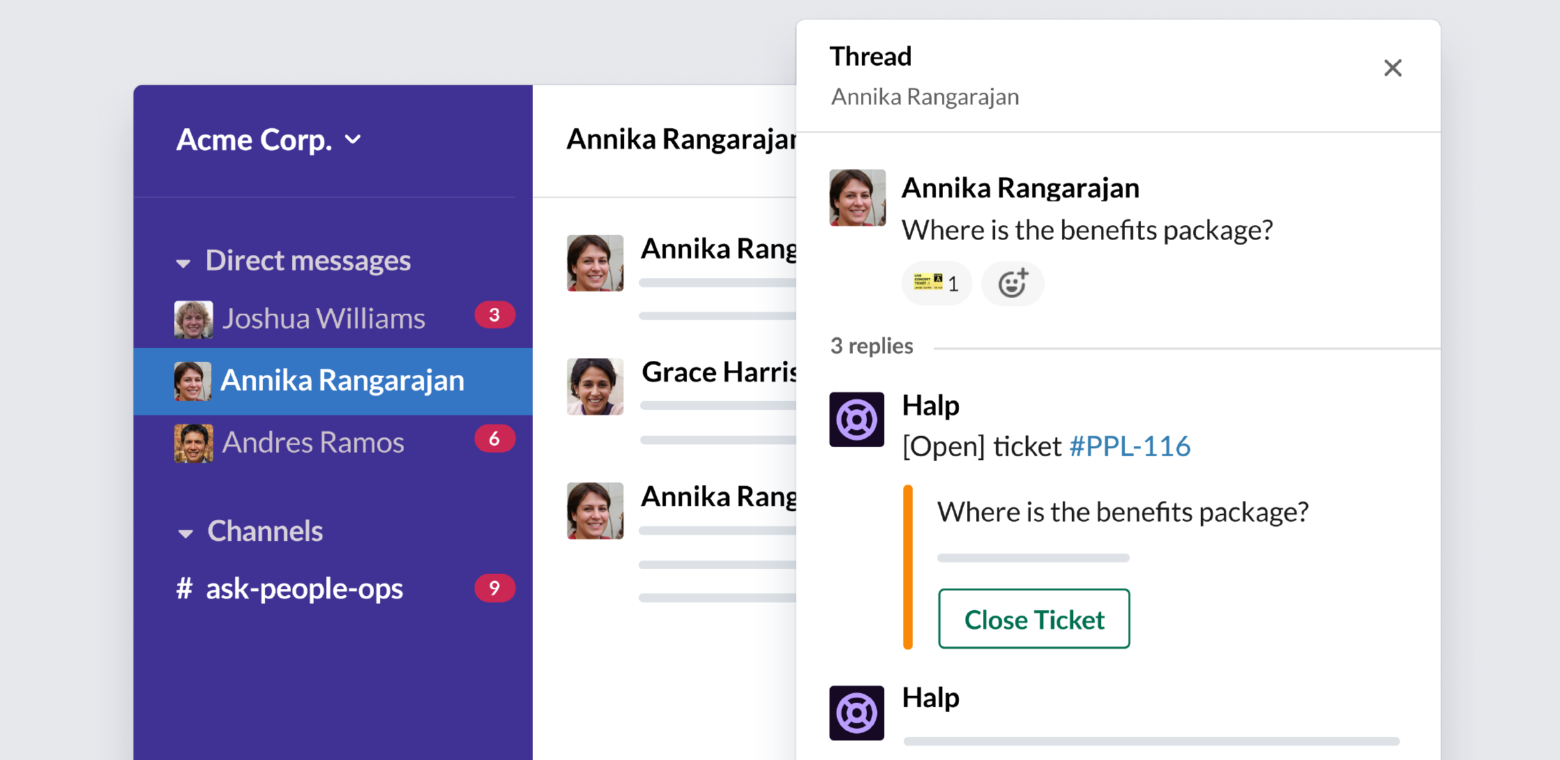4 reasons your People Ops team needs conversational ticketing
Declutter your DMs and turn the flurry of onboarding and benefits questions into trackable tickets.
People Ops teams are at the heart of today’s hybrid-remote organizations. The growing challenges of employee engagement, retention, and collaboration – all vital to business success – rest heavily on their shoulders.
Between Zoom fatigue and meeting overload, many teams have turned to Slack and Microsoft Teams to stay connected, troubleshoot issues, and ask questions. When employees need help with anything from onboarding, to payroll, to the latest COVID-19 policies, HR channels and DMs start to flood.
Even before the pandemic, many People Ops managers were dealing with a backlog of unanswered “@ mentions” across various channels. Now that onslaught of virtual requests is worse than ever, and trying to stay on top of them all creates a major headache.
That’s where conversational ticketing comes in.
Building a virtual People Ops help desk
Conversational ticketing tools like Halp have become critical to controlling the chaos of operating a remote-hybrid business, and the many questions and issues that come with that. Halp allows you to meet your employees where they (and you) already work to run an entire service desk directly from Slack or Microsoft Teams.
Below, we’ve broken down five ways HR and People Ops teams can use Halp’s conversational ticketing solution to better manage business-wide requests with ease:
1. Bring order to inbox chaos and eliminate context-switching
Context-switching is a productivity killer. Jumping back and forth between chat, email, and additional task management or human resource tools can stop your flow and reduce productivity by up to 40%. By operating your HR service desk out of Slack or Microsoft Teams, you can capture, track, resolve, and report on requests all in one place, without derailing another task or conversation.
Halp also helps with bringing order to your Slack inbox. Easily consolidate requests from all directions into a designated channel. Rather than setting and snoozing countless reminders, use reaction emojis or message actions to instantly create trackable tickets and add requests to orderly People Ops-specific queues. From there you can easily prioritize, assign, and resolve them without losing track of anything.
2. Route requests to the right HR expert
Many employees have a tendency to direct any and all potentially HR-related questions to the same person – even if it doesn’t fall within their job description. From time to time, you’ve likely gotten bombarded with salary questions meant for your compensation analyst or computer setup questions that only your IT team can answer.
Rather than playing telephone, or crowding more than one person’s inbox, Halp makes it easy to route Slack requests to the appropriate team. Set up individual triage queues for each HR function or office location. You can then use Halp to direct relevant tickets to the appropriate team so they can easily prioritize and respond to requests.
3. Spot patterns and gaps in your HR processes
Sometimes you have a sense that a process isn’t working as it should, but anecdotal evidence isn’t enough to convince your team to revisit it. Rather than fielding ad hoc requests scattered across DMs, channels, and emails, Halp gives you a way to actually organize and track everything in one place so you can identify common breakdowns in your HR processes.

For instance, you might find new employees are consistently getting stuck in the final step of registering for benefits, or there is frequent confusion when trying to access required training materials. Halp empowers you to make data-driven decisions about what needs to be improved or revamped across your operations.
Halp offers detailed reporting so you can quantify spikes in requests, as well as track resolution times. This data also makes it easy to justify headcount and guide future resource planning.
4. Keep sensitive matters private
People Ops teams deal in sensitive information, which makes public Slack and Teams channels a tricky place to field HR requests. Halp privacy settings make it easy to keep sensitive information confidential. Move delicate conversations about subjects like salary or health insurance into private DMs without losing track of the ticket and its progress. Halp user management settings also allow you to limit access to ticket information based on role.
Meet your employees where they already work
Supporting your employees through these changing times is tough. Organizations like Slack, G2, and even Atlassian who have struggled with this new way of working rely on conversational ticketing to better handle the challenges of managing requests across remote teams.
If you’re interested in trying it out for yourself, feel free to check out the Halp Slack sandbox, or sign up for a demo below!


